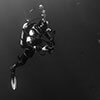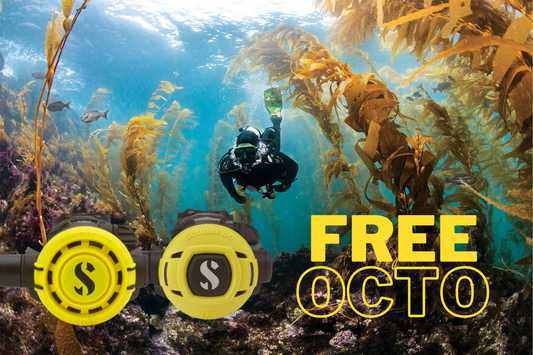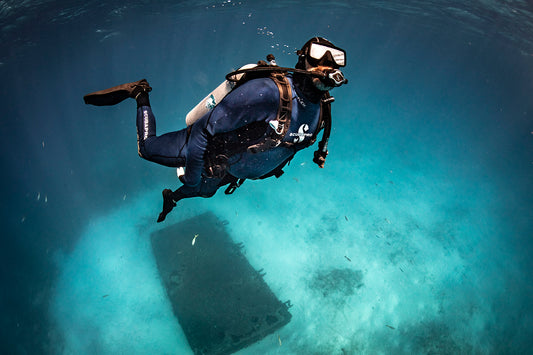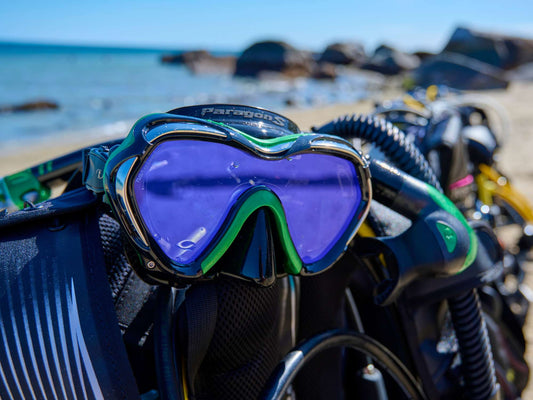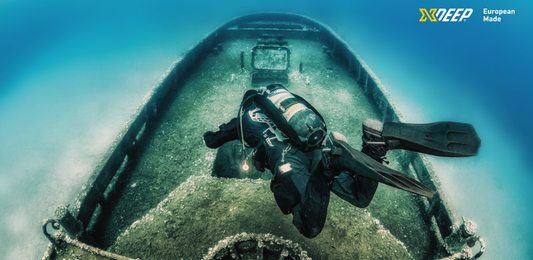A dive knife is an important piece of diving safety equipment but having the biggest knife that you can find strapped to your leg isn't always the best option. For the most part dive knives are there to get us out of trouble if we become snagged or entangled in line, nets or ropes but unless you are trying cut through an inch thick rope you can definitely consider other factors like size, weight, streamlining and positioning when picking your dive knife (or even a backup).
So let's take a look at the different options you have when selecting a dive knife:
- Mounting options
- Material
- Style
- Size
Mounting Options
Rather than starting with picking a knife and then trying to make it fit somewhere it is far easier to decide where you want to mount a knife and then choose a knife that suits that need. There are quite a few mounting options these days with some knives even coming with kits that allow them to be mounted in a variety of ways.
Leg
The leg is the traditional mounting point for a knife and can easily accommodate a large knife in a large sheath secured with two rubber straps. Historically knives were big and heavy so there wasn't really a lot of choice when it can to putting it somewhere. There are downsides to keeping your knife here though as they often become snagged themselves with kelp and seaweed being a regularly annoyance. It isn't the best place to reach either if you do become entangled as you've got to be able to bend and reach down to retrieve it.
Hose
Fixing a small knife in an inverted orientation to the BCD low pressure inflator hose is a popular option that places the knife within easy reach by both hands, making finding and deploying the knife with a downwards action very easy, even in confined spaces. Getting the knife back into the sheath can be a little more tricky if it isn't with your field of view but it is more streamlined and poses less of a snag risk because it is relatively close to the body.
BCD Pocket
A simple solution is to just keep a small knife or line cutter in a BCD pocket. The disadvantage with this option is that it can be a little fiddly to get out and unless you secure the knife back to your BCD there is a chance you can drop it whilst getting it out or putting it away.
BCD Grommets
Most modern BCDs are fitted with pre cut and finished holes on one or both sides, usually just able the pocket. These grommets are designed to accept knives that are supplied with thumb screws or similar attachment fittings that pass through the holes from the inside of the BCD pocket or flap to fix the sheath directly to the BCD. The knife is within easy reach of both hands and remains very streamlined but you do really need to opt for a knife from the same manufacturer as your BCD to ensure a proper fit.
Belt
For those that use a harness style system with lots of empty webbing gaps you could also consider a knife with a sheath that features slots to pass typical width webbing straps through it, safely anchoring the knife in a convenient place that is easy to get to, keeps you streamlined and the knife out of the way for snagging.
Material
Most knives feature a marine grade stainless steel blade which is cost effective to manufacture, is corrosion resistant when looked after and can be easily sharpened when needed. The other popular blade material is titanium as it is lighter, stronger and more resistant to corrosion but it is more expensive and can be harder to sharpen later on. Which every blade you go for it is important to look after it as salt is hugely corrosive and even the best knife will start to degrade if not washed after every dive.
Materials used in the grips and sheaths can vary greatly. Grips will often feature a harder core material for strength wrapped with a softer rubber like material that offers a better grip. Sheaths vary from hard plastic to webbing depending on the style and size of the knife.
Style
Dive knives come in a wide range of shapes and sizes from the simple blade to shears.
Knife
The typical style dive knife is actually a bit of a multi purpose tool in itself in that most knives feature a straight edge for cutting, a serrated edge for sawing through thicker or tougher items like ropes and also a line cutter to quickly cut through fishing lines, nets and other thin lines.
Dive knives often come with a choice of either a point tip which are great for piercing through items or alternatively you can opt for a blunt tip which leaves the end of the blade very much like a wide flat head screwdriver which can very useful for prying and levering items apart.
Line Cutters
Line cutters tend to be compact and lightweight as they only have one simple purpose...to cut line as quickly and efficiently as possible. Most do this by using a sharp blade recessed within a groove that helps to guide the line in towards the blade. Having the blade recessed makes them very safe, significantly reducing the risk of accidental damage or injury. Most line cutters are made from plastic to make them light but titanium versions are also popular.
Shears
Not technically a knife but they fall under the same category and serve the same purpose for divers. Shears (also called Trauma Shears) are very much like scissors with suitably sized finger / thumb loops that will accommodate gloved hands without making them awkward to handle. They are really only good for cutting similar things that you would use scissors for rather than puncturing but they can be used with precision.
Size
The size ultimately depends on where you intend to mount it and your own personal preference. For most divers that want to mount their knife on their leg a small to mid size knife with a blade length of up to 14 or 15cm is more than adequate.
BCD and hose mounted knives all tend to be of a similar size
Shop All Dive Knives










